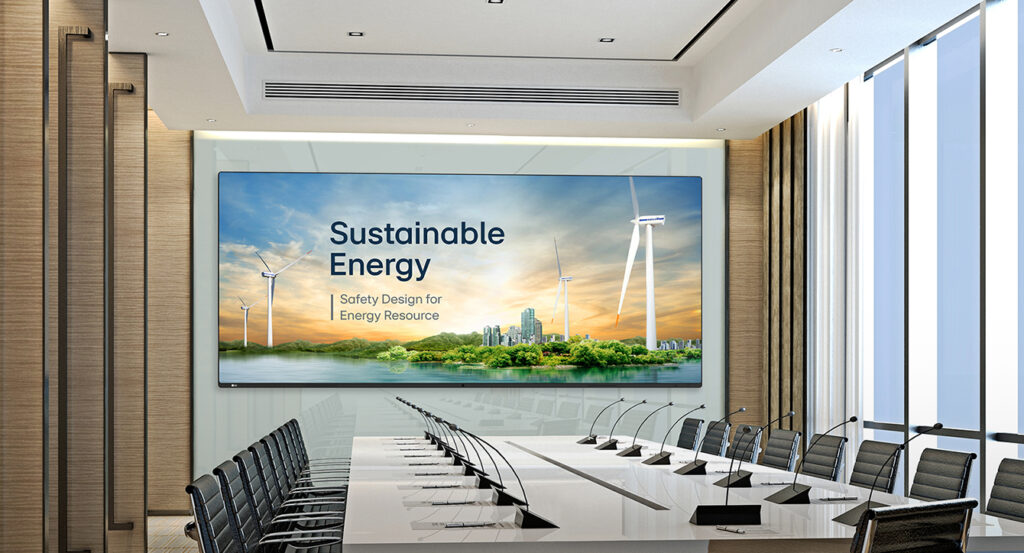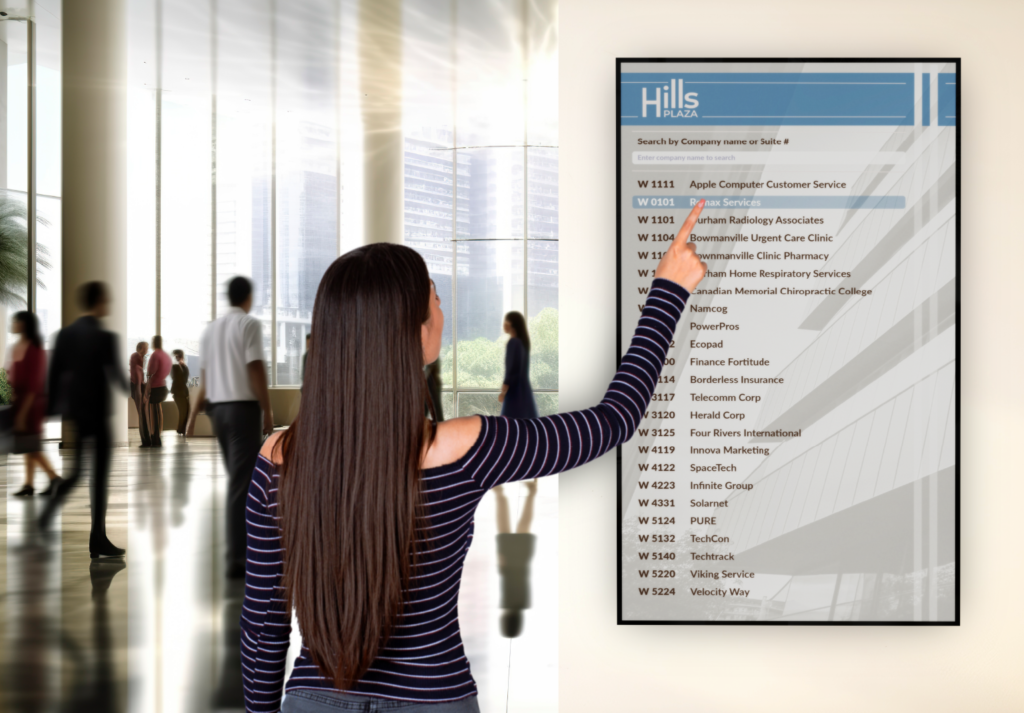The future of outdoor digital signage is increasingly shaped by two key trends: the need for weatherproof displays and the drive toward sustainability. These trends are driven by technological advances, environmental concerns, and the ever evolving business and consumer expectations. Here’s how each aspect is influencing the future of outdoor digital signage:

Weatherproof Digital Signage Displays
Outdoor environments can present unique challenges for digital signage, especially when you have to account for harsh Canadian weather conditions. Not only are outdoor digital displays frequently exposed to extreme weather conditions, but they also have to account for temperature fulgurations, varying humidity levels, as well as dust and other particle contaminants. Thanks to this growing need, modern weatherproofing technology is rapidly advancing to address these pressing challenges.
Durability and Protection
The newest generation of outdoor digital signage is equipped with high-level Ingress Protection (IP) ratings, such as IP65 or higher, which effectively safeguards it against water, dust, and other environmental hazards. From rainstorms to heat, this type of digital signage protection allows for 24/7 problem free operation in a wide range of climates and weather conditions. IP65 digital signage weather protection was created with the needs of business owners in mind, and ensures the safety of their investments more so than ever before.
Temperature Control
Innovations in temperature regulation, such as built-in heating and cooling systems, have become a top priority for the digital signage industry. These systems allow displays to perform seamlessly in extreme environments, help maintain image quality, and prevent damage caused by thermal stress. In short, these advancements ensure that digital signage displays can function optimally in both freezing cold and scorching hot environments.
Anti-Glare and Visibility Enhancements
Ensuring readability in direct sunlight is crucial to the success of any outdoor signage installation. Advances in high brightness digital signage (with brightness levels exceeding 2500 nits), anti-glare coatings, and improved optical bonding help mitigate the impact of glare, and enhance visibility even in bright the brightest daylight. Depending on the type of display you choose, it also might come with smart brightness technology, which will automatically adjust the brightness based on the current lighting conditions.
Vandalism and Impact Resistance
In urban environments, digital signage is often exposed to potential physical damage and various forms of vandalism. Displays are being designed with vandal-resistant materials like tempered glass and reinforced frames to withstand impact and tampering. Some displays such as DV LED Displays allow only single panels to be replaced, making installations much easier and quicker as well.

Outdoor Signage and Sustainability
Sustainability has become a central focus for many companies and organizations who are looking to reduce their environmental impact and carbon footprint. A lower environmental impact has proven to be beneficial for not only a companies social image, but their expenses as well thanks to government subsidies and new regulations. Sustainable digital signage is particularly relevant for outdoor displays where energy use, materials, and operational longevity play more significant roles.
Energy Efficiency
LED technology is the backbone of modern digital signage, and as such has seen numerous advancements since the creation of digital signage. Advancements in energy-efficient LEDS, as well as low-power display systems, are just some of the features that are helping create sustainable outdoor digital signage and reduce its overall carbon footprint. Additionally, solar-power displays are also emerging as a potentially viable option depending on your specific application – especially if used in remote or off-grid locations.
Sustainable Materials and Recycling
Many manufacturers are increasingly opting to use more eco-friendly materials in the production of their digital signage, including big names like LG. These sustainable eco-friendly materials include things such as recycled plastics and metals, as well as displays that are designed for easier recycling at the end of their life cycle. Some companies are also exploring biodegradable or more sustainable packaging for digital signage equipment, which is a trend we expect to continue to grow over time.
Longer Lifespan
The durability of modern digital signage displays not only reduces the need for frequent replacements, but also minimizes waste and paper usage as well. Innovations in component durability, better thermal management, and software that can optimize performance based on environmental conditions all contribute to extending the operational lifespan of these displays. Furthermore, each digital signage screen can effectively completely eliminate the need for paper and traditional advertising, as well as hard to recycle ink and chemicals.
Smart Energy Management for Digital Signage
Many digital signage systems are starting to incorporate sensors and smart software in order to optimize the amount of energy they consume. For example, there are sensors available that can dim your digital signage display when ambient light is lower, or when fewer people are present; this reduces unnecessary power consumption and your overall energy expenditure.

Interactivity and Dynamic Content
The third trend that is shaping the future of outdoor digital signage is the inclusion of interactivity and dynamic content. As touchscreens and other gesture controlled interfaces become more robust and reliable in outdoor settings, outdoor interactive digital signage offers all new ways for user engagement.
AI and Data-Driven Content for Digital Signage
With the integration of of artificial intelligence, or AI tools for digital signage, the capabilities of outdoor digital displays are more powerful than ever. Content tailored to real-time conditions such as weather, audience demographic, or even time of day can be more easily automated on any screen. For example, an AI-powered display might show sunscreen ads on a sunny day, or automatically promote warm beverages during cold weather.
Cloud-Based Management
Cloud-based management for digital signage has seen multiple advancements in recent years, making this useful software even more indispensable. Advances in cloud-based technology now allow for centralized management of outdoor digital signage across multiple locations. This makes it much easier than ever before to update content remotely, further reducing the need for physical intervention and cutting down on travel-related emissions.
In Conclusion
In conclusion, the future of outdoor digital signage lies at the intersection of robust, weatherproof technology and sustainable, energy-efficient solutions. As the demand for outdoor digital advertising and public information systems grows, manufacturers and companies will need to focus on creating displays that not only endure environmental challenges but also align with global sustainability goals. This will likely involve a combination of durable hardware, eco-friendly materials, and smart, energy-efficient operations.
Related Posts

Sustainable Solutions: How Digital Signage Helps American Businesses Go Green
As sustainability becomes an increasing priority for modern American businesses, many business owners are looking for innovative ways to reduce their carbon footprint and adopt eco-friendly practices. Digital signage offers a compelling

Adapting Digital Signage for Seasonal Campaigns and Holiday Promotions
The holidays are fast approaching, which means many businesses are gearing up for their holiday marketing campaigns, promotions, and initiatives. There are many ways to use digital signage for holiday

5 Ways to Use Outdoor Digital Signage
Outdoor digital signage has become extremely popular in recent years and for a very good reason. This incredible technology has seen numerous advancements that allow it to be a staple

The Future of Outdoor Digital Signage: Weatherproof Displays and Sustainability
The future of outdoor digital signage is increasingly shaped by two key trends: the need for weatherproof displays and the drive toward sustainability. These trends are driven by technological advances,

